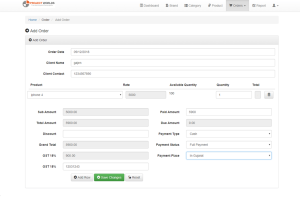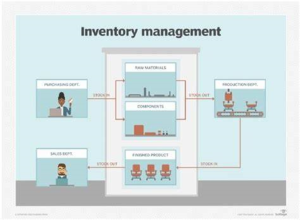Inventory planning is a critical process for businesses, involving the determination of optimal stock quantity and timing to align with sales and production capacity. This plays a significant role in managing cash flow, maximizing profits, and ensuring an efficient supply chain. To achieve this, businesses rely on efficient tracking mechanisms, which can be facilitated by implementing a point-of-sale (POS) system or inventory management software.
Within the complex framework of the Goods and Services Tax (GST) regime, the E-waybill system stands as a crucial tool designed not only to combat tax evasion but also to meticulously track the movement of goods, ensuring compliance with GST laws. One must remember the generation of an E-waybill becomes mandatory when the value of goods in transit exceeds INR 50,000.
Robust stock management and accurate inventory records emerge as essential prerequisites for the smooth functioning of this process, ensuring that the movement of goods precisely aligns with the stringent requirements of E-waybill generation.

World-class organizations like Samsung and Amazon are the best examples one can learn lessons from. They have understood what is needed for their businesses and selected the right inventory management system tailored to their specific budget, operational needs, and organizational size for a seamless E-waybill generation process.
Maintaining Compliance Matters
A part of the process is compliance. Businesses can undertake a series of strategic steps such as implementing an end-to-end inventory tracking system that provides real-time updates on stock levels across multiple facilities while also offering a critical tool for monitoring the movement of goods – a pivotal aspect for E-waybill generation.
Furthermore, analyzing customer demand patterns aids in determining optimal stocking levels, ensuring that the movement of goods aligns harmoniously with accurate inventory records, thereby facilitating compliance with E-waybill requirements.
Regular assessment of supplier performance becomes imperative, not only for maintaining quality standards but also for averting potential discrepancies in inventory records that could lead to non-compliance with E-waybill requisites. Keeping up to date of technological advancements, such as inventory management software, allows for the automation of reordering processes, ensuring optimal stock levels are maintained.
Setting threshold stock levels is particularly significant in the context of E-waybill generation, as the creation of an E-waybill becomes mandatory whenever the value of goods in transit surpasses a predetermined threshold. Efficient management of returns assumes critical importance in maintaining accurate inventory records, a crucial aspect for E-waybill compliance.
Consistent monitoring of stocks serves as a proactive measure, enabling businesses to identify and rectify any discrepancies in inventory records promptly. By following these proactive steps, businesses lay a robust foundation, ensuring that their stock management and inventory records are well-equipped for seamless E-waybill generation.
Stock Management and Inventory
Achieving success in stock management and inventory records for E-waybill compliance requires a comprehensive approach encompassing several key steps. Understanding inventory planning involves strategically determining the right amount of inventory to have on hand and the appropriate timing for replenishment. This necessitates an in-depth analysis of demand, forecasting future needs, and implementing systems to ensure optimal stock levels.
Estimating demand relies on analyzing historical sales data, trends, and market conditions. Creating a replenishment plan ensures a smooth flow of production and restocking, requiring the determination of the reorder point and reorder quantity. Efficient tracking mechanisms facilitated by point-of-sale (POS) systems or inventory management software become vital for effective inventory management.
Managing inventory effectively involves various practices, from timely ordering to proper receiving, tracking, and storage. These aspects collectively contribute to the overall efficiency of inventory control and supply chain processes. By following these steps, businesses can leverage a comprehensive approach to stock management and inventory records, ensuring optimal alignment with E-waybill compliance and overall success.
Also Read: Navigate These Inventory Management Challenges Using Small Business Software
On-Time Replenishment Ensures Smooth Operations
Optimizing processes related to stock management and inventory records involves considering many options on the go. Inventory planning takes center stage, demanding a critical analysis of optimal quantity and timing to synchronize with sales and production capacity. The estimation of demand relies on historical sales data, market trends, and an understanding of external factors like scarcity, competition, and customer preferences.
A well-defined replenishment plan becomes integral to ensure a seamless flow of production and restocking, necessitating the determination of the reorder point and quantity. Efficient tracking mechanisms, facilitated by systems like point-of-sale (POS) systems or inventory management software, allow businesses to monitor stock levels, track sales, and automate reordering.

Technology plays a crucial role in inventory tracking, with tools like barcode scanners or RFID tags enhancing the accuracy of recording and updating inventory data in real time. Mastering inventory control involves considering demand patterns, lead times, production capacity, and customer service levels. Accurate demand forecasting emerges as a vital component in determining appropriate inventory levels to meet customer demands without excessive stockholding.
By considering these key aspects, businesses can optimize their stock management and inventory record processes, laying the groundwork for successful E-waybill generation.
Also Read: Who Is Required To Generate An E-Way Bill?
Effective and Efficient
Large Organizations such as Amazon and Samsung for example have effectively and efficiently managed their stock and inventory in E-waybill processes. Some lessons learned are maintaining a robust Inventory management, including processes for producing, ordering, storing, and selling products. Effective strategies for monitoring inventory levels and determining replenishment needs play a critical role in maintaining the right amount of inventory, leading to higher profits and operational efficiency.
The benefits of effective inventory management extend beyond the immediate operations domain, influencing aspects such as cost reduction, improved customer service, and increased productivity. Automation, a key takeaway from successful businesses, allows for the streamlining of operations, freeing up staff to focus on other critical aspects of their operations. It also reduces manual errors and facilitates real-time tracking of inventory levels.
Labeling and tracking are considered essential practices in stock control and inventory management. It involves accurate labeling of items, monitoring stock levels, and setting thresholds using digital tools. These practices collectively contribute to the overall efficiency and profitability of businesses managing their stock and inventory obligations related to E-waybill processes.
Stock Management and Inventory Records
An increase in sales and revenue becomes achievable by stocking up on products that resonate with customers, meeting their demands effectively. Also, improved cash flow results from proper planning, preventing capital from being tied up in excess inventory and enabling businesses to allocate resources more effectively.
This is made possible when storage capacity in warehouses or storage locations becomes feasible through efficient inventory planning, ensuring sufficient space for revenue-generating merchandise. Enhanced customer satisfaction, a direct outcome of having the right products available at the right time, fosters loyalty and contributes positively to a business’s bottom line. Minimized overstocks and stockouts, consequences of effective inventory planning, lead to better cost management and improved customer service.
Optimized supply chain operations, another advantage of a well-executed strategy, involve lowering inventory levels to reduce associated expenses, thereby freeing up capital for other critical operational aspects. Reduced costs, achieved through alternative inventory management methods like drop-shipping or consignment, contribute to the financial health and sustainability of businesses. Increased accuracy and productivity result from continuous improvement and optimization of inventory operations.
By implementing these strategies, businesses can not only ensure compliance with E-waybill requirements but also improve their overall efficiency, profitability, and competitiveness. A comprehensive approach to inventory management, encompassing strategic forecasting skills, technological integration, and efficient operational practices, positions businesses to thrive in the dynamic landscape of E-waybill compliance.
In conclusion, the subtle yet strong link between adequate stock management, precise inventory records, and the intricacies of E-waybill compliance forms a crucial nexus for businesses operating in a dynamic economic environment.
Businesses that strategically navigate stock management, implement effective inventory records, and adopt proactive measures position themselves not just for compliance but for sustainable growth and success.
The lessons learned from industry leaders, the proactive steps outlined, and the advantages of a well-executed strategy collectively contribute to a comprehensive guide for businesses aiming to seamlessly integrate stock management and inventory records with the stringent requirements of E-waybill compliance.
Also Read: Challenges and Solutions in Import E-waybill Compliance: Cross-border Considerations
Frequently Asked Question
-
Why is inventory planning crucial for businesses?
Inventory planning is crucial for optimizing resources, maximizing profits, and maintaining an efficient supply chain by aligning stock levels with demand.
-
When does the generation of an E-waybill become mandatory?
The E-waybill is mandatory when the value of goods in transit under the GST regime surpasses INR 50,000.
-
How do world-class organizations like Samsung and Amazon approach inventory management for E-waybill compliance?
Leading organizations customize inventory management systems to align with their specific requirements, ensuring compliance with E-waybill regulations.
-
Why is compliance important in the context of E-waybill generation?
Compliance is crucial for E-waybill generation, and strategic steps like end-to-end inventory tracking ensure accurate records and monitor the movement of goods.
-
How does analyzing customer demand patterns contribute to E-waybill compliance?
Analyzing customer demand patterns aids in maintaining optimal stocking levels, aligning with accurate inventory records for E-waybill compliance.
-
Why is regular assessment of supplier performance imperative for E-waybill compliance?
Regular assessment of supplier performance is crucial to maintain quality standards and avoid discrepancies in inventory records, ensuring E-waybill compliance.
-
What is the significance of setting threshold stock levels in E-waybill generation?
Setting threshold stock levels is significant, as the creation of an E-waybill becomes mandatory when the value of goods in transit surpasses a predetermined threshold.
-
Why is efficient management of returns important for E-waybill compliance?
Efficient management of returns is important for maintaining accurate inventory records, contributing to E-waybill compliance.
-
How does consistent monitoring of stocks contribute to E-waybill compliance?
Consistent monitoring of stocks is a proactive measure that helps identify and rectify discrepancies in inventory records, contributing to E-waybill compliance.
-
What benefits do businesses gain from effective inventory management for E-waybill compliance?
Effective inventory management for E-waybill compliance leads to increased sales, improved cash flow, enhanced customer satisfaction, and optimized supply chain operations.

